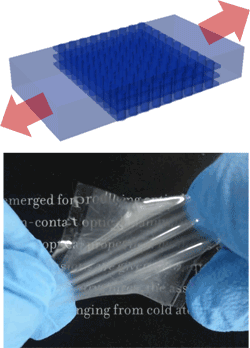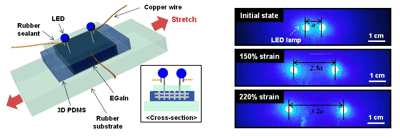New technology offers tremendous versatility
Researchers out of Northwestern University have developed a new method for creating highly stretchable electronics that could one day be used for everything from bendable laptops to medical devices integrated in the human body.

Researchers have discovered a way to stretch electronics.
This development overcomes a major hurdle with the technology; that is, that electronics are way too rigid.
The discovery
A team of researchers at the McCormick School of Engineering, working alongside scientists from the United State and elsewhere, developed a design that allows electronics to bend and stretch more than 200% their original size.
That’s three times greater than what’s possible with current technology.
The solution, they found, was discovered via a combination of porous polymer and liquid metal.

Researchers have created a stretchable material that is also highly conductive.
Why this is a big deal?
“With current technology, electronics are able to stretch a small amount, but many potential applications require a device to stretch like a rubber band,” said Yonggang Huang, Joseph Cummings Professor of Civil and Environmental Engineering and Mechanical Engineering, who conducted the research with partners at the Korea Advanced Institute of Science and Technology (South Korea), Dalian University of Technology (China), and the University of Illinois at Urbana-Champaign. “With that level of stretchability we could see medical devices integrated into the human body.”
In the past five years, Huang and collaborators at the University of Illinois have developed electronics with about 50% stretchability. It’s an impressive feat, but not enough for many of the applications that Huang is suggesting here.
What they did
The biggest problem that researchers faced was overcoming a loss of conductivity in stretchable electronics. Today’s circuits, made from solid metals, can survive a little bit of a stretching, but their electrical conductivity drops by 100 times when stretched.
“This conductivity loss really defeats the point of stretchable electronics,” Huang explained.
To get past this issue, the team created a highly porous three-dimensional structure using a polymer material, polydimethylsiloxane (PDMS). The material can stretch up to four times its original size. Then they placed a liquid metal (EGaIn) inside the pores. Doing this, they found, allowed electricity to flow consistently, even when the material was stretched excessively.
The result is a material that is both highly stretchable and extremely conductive.

The technology’s unique set-up allows it to be both highly stretchable as well as extremely conductive.
“By combining a liquid metal in a porous polymer, we achieved 200% stretchability in a material that does not suffer from stretch,” Huang said. “Once you achieve that technology, any electronic can behave like a rubber band.”
Video
In the following video, you can see just how much the material can stretch:
Impressive stuff!
Learn more
The team’s paper, “Three-dimensional Nanonetworks for Giant Stretchability in Dielectrics and Conductors,” was published June 26 in the journal Nature Communications. ■
Story via: northwestern.edu
Advertisement
Learn more about Electronic Products Magazine





